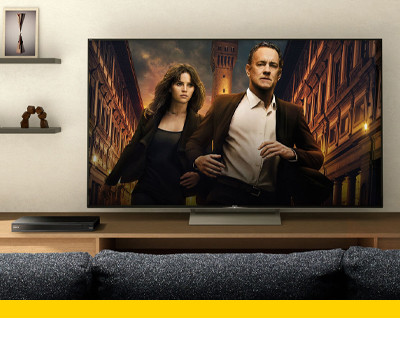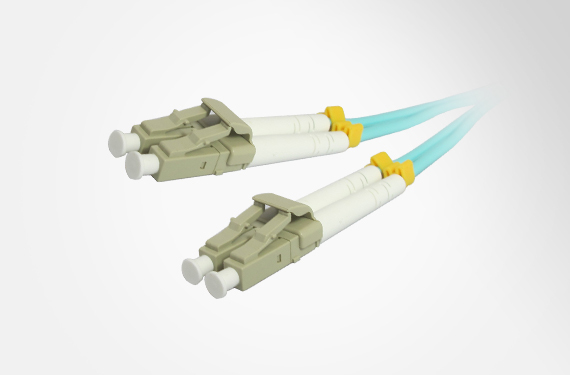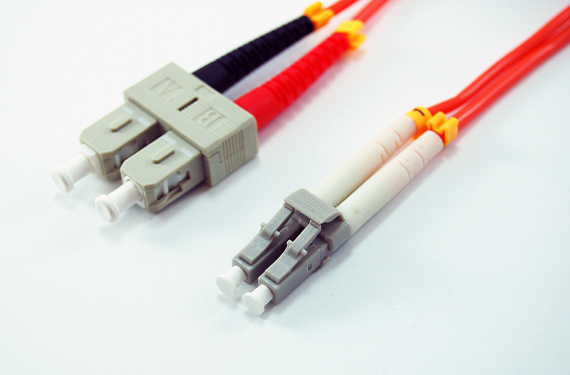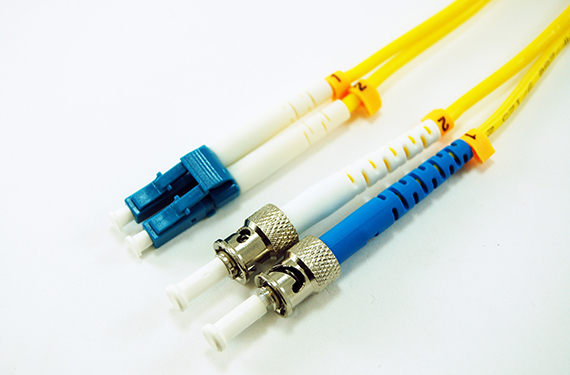Fiber optics, or optical fibers, are long, thin strands of carefully drawn glass about the diameter of a human hair. These strands are arranged in bundles called optical cables. We rely on them to transmit light signals over long distances.
At the transmitting source, the light signals are encoded with data. The same data you see on the screen of a computer. So, the optical fiber transmits “data” by light to a receiving end, where the light signal is decoded as data. Therefore, fiber optics is actually a transmission medium – a “pipe” to carry signals over long distances at very high speeds.
Optical Fiber History
 Fiber optic cables were originally developed in the 1950’s for endoscopes. The purpose was to help doctors view the inside of a human patient without major surgery.
Fiber optic cables were originally developed in the 1950’s for endoscopes. The purpose was to help doctors view the inside of a human patient without major surgery.In the 1960s, telephone engineers found a way to use the same technology to transmit and receive telephone calls at the “speed of light”. That is about 186,000 miles per second in a vacuum, but slows to about two-thirds of this speed in a cable.
How Does Optical Fiber Work?
Light travels down a fiber optic cable by bouncing off the walls of the cable repeatedly. Each light particle (photon) bounces down the pipe with continued internal mirror-like reflection. The light beam travels down the core of the cable, the core is the middle of the cable and the glass structure and the cladding is another layer of glass wrapped around the core. Cladding is there to keep the light signals inside the core.
Types of Optical Fiber
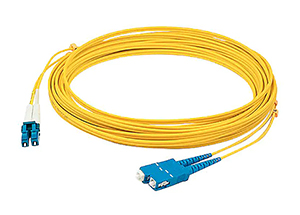 Single mode fiber is the simplest structure. It contains a very thin core, and all signals travel straight down the middle without bouncing off the edges.
Single mode fiber is the simplest structure. It contains a very thin core, and all signals travel straight down the middle without bouncing off the edges. Single mode fiber optic cables are typically used for CATV, Internet, and telephone applications, where the signals are carried by single mode fibers wrapped into a bundle.
Multimode fiber is the other type of fiber optic cable. It is about 10 times larger than a single mode cable. The light beams can travel though the core by following a variety of different paths, or in multiple different modes. These cable types can only send data over short distances. Therefore, they are used, among other applications, for interconnecting computer networks.
There are four types of multimode fiber optic cables, identified by “OM” (optical multimode), an industry association designated them as OM1, OM2, OM3 and OM4. Each OM has a minimum Modal Bandwidth requirement, explanation of these below.
 Multimode Fiber Types
Multimode Fiber TypesThere are a few different types of fiber types identified by OM1 (62.5/125), OM2(50/125), OM3 and OM4. The main differences between these are the amount of bandwidth the cable can support. As we know the greater the bandwidth the more signal we can send over the cable. This is in regards to Multi Mode and not Single Mode Fiber.
OM1, Also Known as 62.5/125μm Fiber
MHz 200/500 MHz
OM2, Also Known as 50/125μm Fiber
MHz 500/500 MHz
OM3, Also Known as 50μm Fiber for 10Gbs Transmission
MHz 2000 MHz

OM4, Also Known as 50μm Laser Optimized Fiber for 40-100Gbs Transmission
MHz 4700 MHz
A μm is a micrometer, or micron is a unit of length equal to 106 meters. μm is therefore equal to 2.5 X 10-6 m, which is about equal to the width of a single strand of spider web silk.
Multimode fiber optic cables are used as patch cords or “jumpers” to interconnect data equipment.
Singlemode Fiber Signal, 9 μm core

Multimode Fiber Signal, 50/62.5 μm core

What is Simplex and Duplex Optical Fiber?
Simplex fiber optic cable constructions contain a single strand of glass. Most often, simplex fiber is used where only a single transmit and/or receive line is required between devices or when a multiplex data signal is used (bi-directional communication over a single fiber).
Duplex fiber cable consists of two strands of glass or plastic Fiber Optic Cable on Crate Reel, with Pre-terminated ends fiber. Typically found in a “zip cord” construction format, this cable is most often used for duplex communication between devices where a separate transmit and receive are required.
Duplex fiber cable consists of two strands of glass or plastic Fiber Optic Cable on Crate Reel, with Pre-terminated ends fiber. Typically found in a “zip cord” construction format, this cable is most often used for duplex communication between devices where a separate transmit and receive are required.
Uses of Optical Fiber in Our Daily Life
You may have seen plastic fibers carrying colored lights in decorative applications. What you may not have seen are the real glass fiber optic cables that are now the foundation of our communication and computer networks. Many thousands of miles of installed fiber optic cable carry many types of information underground, in tunnels, building walls, ceilings, and other places you don’t see. Examples of uses of optical fiber in our daily life include applications such as:
-
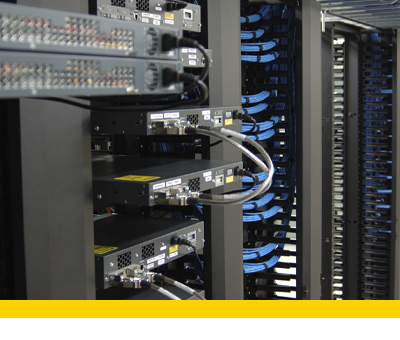
Computer Networking -

Broadcasting -
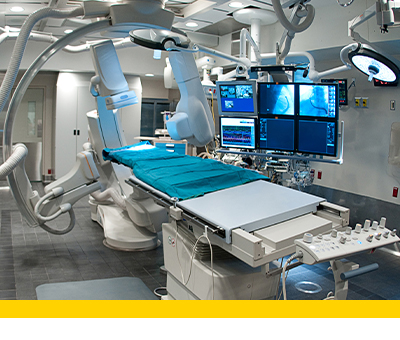
Medical Scanning & Surgery -
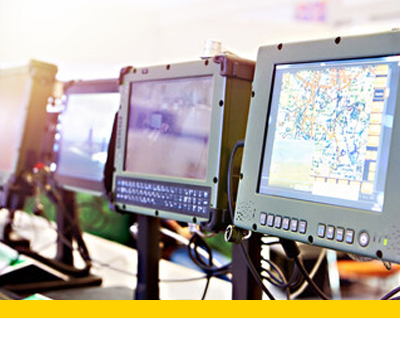
Military Equipment
Fiber Optic Solutions from Comprehensive
Comprehensive's fiber optic cables are known for their efficiency. Lighter and able to carry more data than a standard copper cable, a fiber optic cable is made of strands of glass fibers that can transmit data at high speeds over long distances. Comprehensive's fiber optic cables are 100% optically inspected and tested for insertion loss and come with a worry-free Lifetime Warranty.
Comprehensive's fiber optic cables are known for their efficiency. Lighter and able to carry more data than a standard copper cable, a fiber optic cable is made of strands of glass fibers that can transmit data at high speeds over long distances. Comprehensive's fiber optic cables are 100% optically inspected and tested for insertion loss and come with a worry-free Lifetime Warranty.
Fiber Optic FAQs
Q: What is optical fiber?
A: Optical fiber is a glass or plastic filament that guides a light wave along its path.
Q: What is multimode fiber?
A: Multimode fiber is optical fiber that allows light to travel down multiple paths, also referred to as modes. It features a core diameter of 50 to 62.5 microns. Multimode fiber can be used to transmit AV signals in short to intermediate-distance applications, such as within a building.
Q: What is singlemode fiber?
A: Singlemode fiber is optical fiber that allows light to travel down a single path known as the fundamental mode. It features a core diameter of 8 to 9 microns. Singlemode fiber can be used to transmit AV signals over extreme distances up to many miles or kilometers.
Q: How is an AV signal transmitted down a fiber?
A: A fiber optic transmitter converts the AV signal into an optical signal, using a VCSEL or laser diode as a light source. A glass fiber guides the optical AV signal along its path. A photodetector in a fiber optic receiver at the far end of the fiber converts the optical AV signal back into an electrical AV signal.
Q: What is a light-emitting diode?
A: A light-emitting diode — LED is a semiconductor device that emits light when an electrical current passes through it. An LED that emits visible light is used in a variety of applications, including signage, area lighting, numerical displays, and indicator lights on electrical equipment. In fiber optics, an LED is used as a light source for low-speed signals such as, TOSLINK or 100BASE-SX Ethernet, due to its low cost. An LED is not recommended for transmitting high speed video signals over fiber.
Q: What is a laser diode?
A: A laser diode is a semiconductor device that emits a narrow beam of coherent light, such as the beam of light from a laser pointer. In AV fiber optic transmitters, laser diodes are used as the light source for transmitting video, audio, and control signals.
Q: What is a VCSEL?
A: VCSEL stands for Vertical Cavity Surface Emitting Laser. A VCSEL is a special type of laser diode that has lower manufacturing costs than other types of laser diodes. It can be mass-produced with high yield rates and has a smaller PCB footprint, making it ideal for use in fiber optic transmitters to send high resolution video, audio, and control signals.
Q: What is a photodetector?
A: A photodetector is a semiconductor device that converts an optical signal into an electrical signal. A photodetector is used in a fiber optic receiver to convert optical AV signals.
Q: What wavelengths are used with multimode fiber?
A: Multimode fiber is capable of transmitting a wavelength at or around 850 nm, 1300 nm, or 1550 nm. The most common wavelengths are 850 nm and 1300 nm due to the availability of low cost semiconductor light sources and photodetectors.
Q: What wavelengths are used with singlemode fiber?
A: The most common wavelengths are 1310 nm and 1550 nm. At 1310 nm, chromatic dispersion is near zero, and at 1550 nm, attenuation is near its minimum. In OS1 singlemode fiber, wavelengths around 1390 nm should be avoided due to high attenuation caused by absorption. OS2 singlemode fiber is capable of transmitting any wavelength above its cutoff wavelength, which is typically around 1250 nm.
Q: How is an electrical AV signal converted into an optical AV signal?
A: An electrical AV signal is converted into an optical AV signal using an optical transmitter or an electrical-to-optical converter. An optical transmitter uses a laser diode as the light source, varying the intensity of the laser light in accordance with the electrical signal. For an analog signal, the intensity of the light source varies with the voltage or current of the electrical signal. For digital signals, the light intensity is high or low, which represents logical ones or zeros.
Q: How is an optical AV signal converted back into an electrical AV signal?
A: An optical signal is converted into an electrical signal using an optical receiver or an optical-to-electrical converter. The optical receiver uses a photodetector to receive the optical signal and convert it into an electrical signal.
Q: What are the advantages of fiber optic AV systems in medical applications?
A: Medical systems need to isolate electrical equipment from the patient for safety, usually have space constraints for cable runs, and must limit the effect of electrical interference on other sensitive medical equipment. Additionally, high-voltage video displays must be isolated from medical imaging machines. Often, the displays are mounted on booms so that they can be adjusted for optimal viewing by the surgeon and other medical staff. This type of mounting system requires that the cabling medium be small but also strong. Since fiber optic cables are made of glass, they isolate displays from medical imaging devices, are small enough to fit inside of mounting booms, and emit no electrical signals that could affect other equipment.
Q: How can fiber optic technology future-proof an AV system?
A: The transition to digital video standards and higher resolutions has revealed the many limitations of copper cabling. High resolution digital video signals run at multi-gigabit data rates, pushing copper cabling to its limits. Installing fiber optic cables in today's systems provides a path for future video signals. Fiber optic cable is an ideal cabling solution for the multi-gigabit data rates and long distances required in future AV systems.
Q: When should singlemode fiber be used in an AV system?
A: Singlemode fiber is optimal for long haul transmissions of up to 30 km (18.75 miles). It is ideal for transmitting signals between buildings on a university or corporate campus. It can also be used for long haul transmission between separate facilities.
Q: When should multimode fiber be used in an AV system?
A: Multimode fiber is used to transmit signals for hundreds of meters or thousands of feet. It is ideal for transmitting signals between floors of a building, or from an equipment room to a wide variety of presentation rooms and spaces.
Q: What type of multimode fiber should be used for new installations?
A: OM4 or better multimode fiber is recommended for all new installations. The resolution and color depth of video signals continue to climb. OM4 or better fiber optic cable provides a level of future proofing as video resolution and data rates continue to rise.
Q: Why is singlemode fiber less costly than multimode fiber?
A: Singlemode fiber has a step index core, while multimode fiber has a graded index core with very tight performance requirements. Therefore, singlemode fiber is less costly to manufacture.
Q: Why not always use singlemode fiber?
A: Laser light sources and photodetectors used for singlemode applications are significantly more expensive than those used for multimode. This difference translates into higher equipment costs for singlemode systems.
Q: What happens if I bend a fiber too far?
A: Bending fiber beyond the minimum bend radius causes loss in the fiber optic signal, and could potentially damage the fiber.
Q: Can fiber optic light cause harm?
A: Although the light used for fiber optic transmission is in the infrared range and is not visible to the human eye, it can still cause damage. Laser light is a concentrated beam that can cause injury or blindness. Avoid looking into a fiber if it is unknown whether there is an active light source.
Q: Simplex and Duplex cables – What is the difference between them?
A: Simplex cables consist of a single strand of glass fiber and is widely used when a single transmit/receive line is required between devices. Duplex cables consist of two strands of glass fiber and are used in situations where separate transmit and receive lines are required.
Q: Do single mode connectors work on multimode cables?
A: Yes, you can use single mode connectors on multimode, but not the other way around.
A: Optical fiber is a glass or plastic filament that guides a light wave along its path.
Q: What is multimode fiber?
A: Multimode fiber is optical fiber that allows light to travel down multiple paths, also referred to as modes. It features a core diameter of 50 to 62.5 microns. Multimode fiber can be used to transmit AV signals in short to intermediate-distance applications, such as within a building.
Q: What is singlemode fiber?
A: Singlemode fiber is optical fiber that allows light to travel down a single path known as the fundamental mode. It features a core diameter of 8 to 9 microns. Singlemode fiber can be used to transmit AV signals over extreme distances up to many miles or kilometers.
Q: How is an AV signal transmitted down a fiber?
A: A fiber optic transmitter converts the AV signal into an optical signal, using a VCSEL or laser diode as a light source. A glass fiber guides the optical AV signal along its path. A photodetector in a fiber optic receiver at the far end of the fiber converts the optical AV signal back into an electrical AV signal.
Q: What is a light-emitting diode?
A: A light-emitting diode — LED is a semiconductor device that emits light when an electrical current passes through it. An LED that emits visible light is used in a variety of applications, including signage, area lighting, numerical displays, and indicator lights on electrical equipment. In fiber optics, an LED is used as a light source for low-speed signals such as, TOSLINK or 100BASE-SX Ethernet, due to its low cost. An LED is not recommended for transmitting high speed video signals over fiber.
Q: What is a laser diode?
A: A laser diode is a semiconductor device that emits a narrow beam of coherent light, such as the beam of light from a laser pointer. In AV fiber optic transmitters, laser diodes are used as the light source for transmitting video, audio, and control signals.
Q: What is a VCSEL?
A: VCSEL stands for Vertical Cavity Surface Emitting Laser. A VCSEL is a special type of laser diode that has lower manufacturing costs than other types of laser diodes. It can be mass-produced with high yield rates and has a smaller PCB footprint, making it ideal for use in fiber optic transmitters to send high resolution video, audio, and control signals.
Q: What is a photodetector?
A: A photodetector is a semiconductor device that converts an optical signal into an electrical signal. A photodetector is used in a fiber optic receiver to convert optical AV signals.
Q: What wavelengths are used with multimode fiber?
A: Multimode fiber is capable of transmitting a wavelength at or around 850 nm, 1300 nm, or 1550 nm. The most common wavelengths are 850 nm and 1300 nm due to the availability of low cost semiconductor light sources and photodetectors.
Q: What wavelengths are used with singlemode fiber?
A: The most common wavelengths are 1310 nm and 1550 nm. At 1310 nm, chromatic dispersion is near zero, and at 1550 nm, attenuation is near its minimum. In OS1 singlemode fiber, wavelengths around 1390 nm should be avoided due to high attenuation caused by absorption. OS2 singlemode fiber is capable of transmitting any wavelength above its cutoff wavelength, which is typically around 1250 nm.
Q: How is an electrical AV signal converted into an optical AV signal?
A: An electrical AV signal is converted into an optical AV signal using an optical transmitter or an electrical-to-optical converter. An optical transmitter uses a laser diode as the light source, varying the intensity of the laser light in accordance with the electrical signal. For an analog signal, the intensity of the light source varies with the voltage or current of the electrical signal. For digital signals, the light intensity is high or low, which represents logical ones or zeros.
Q: How is an optical AV signal converted back into an electrical AV signal?
A: An optical signal is converted into an electrical signal using an optical receiver or an optical-to-electrical converter. The optical receiver uses a photodetector to receive the optical signal and convert it into an electrical signal.
Q: What are the advantages of fiber optic AV systems in medical applications?
A: Medical systems need to isolate electrical equipment from the patient for safety, usually have space constraints for cable runs, and must limit the effect of electrical interference on other sensitive medical equipment. Additionally, high-voltage video displays must be isolated from medical imaging machines. Often, the displays are mounted on booms so that they can be adjusted for optimal viewing by the surgeon and other medical staff. This type of mounting system requires that the cabling medium be small but also strong. Since fiber optic cables are made of glass, they isolate displays from medical imaging devices, are small enough to fit inside of mounting booms, and emit no electrical signals that could affect other equipment.
Q: How can fiber optic technology future-proof an AV system?
A: The transition to digital video standards and higher resolutions has revealed the many limitations of copper cabling. High resolution digital video signals run at multi-gigabit data rates, pushing copper cabling to its limits. Installing fiber optic cables in today's systems provides a path for future video signals. Fiber optic cable is an ideal cabling solution for the multi-gigabit data rates and long distances required in future AV systems.
Q: When should singlemode fiber be used in an AV system?
A: Singlemode fiber is optimal for long haul transmissions of up to 30 km (18.75 miles). It is ideal for transmitting signals between buildings on a university or corporate campus. It can also be used for long haul transmission between separate facilities.
Q: When should multimode fiber be used in an AV system?
A: Multimode fiber is used to transmit signals for hundreds of meters or thousands of feet. It is ideal for transmitting signals between floors of a building, or from an equipment room to a wide variety of presentation rooms and spaces.
Q: What type of multimode fiber should be used for new installations?
A: OM4 or better multimode fiber is recommended for all new installations. The resolution and color depth of video signals continue to climb. OM4 or better fiber optic cable provides a level of future proofing as video resolution and data rates continue to rise.
Q: Why is singlemode fiber less costly than multimode fiber?
A: Singlemode fiber has a step index core, while multimode fiber has a graded index core with very tight performance requirements. Therefore, singlemode fiber is less costly to manufacture.
Q: Why not always use singlemode fiber?
A: Laser light sources and photodetectors used for singlemode applications are significantly more expensive than those used for multimode. This difference translates into higher equipment costs for singlemode systems.
Q: What happens if I bend a fiber too far?
A: Bending fiber beyond the minimum bend radius causes loss in the fiber optic signal, and could potentially damage the fiber.
Q: Can fiber optic light cause harm?
A: Although the light used for fiber optic transmission is in the infrared range and is not visible to the human eye, it can still cause damage. Laser light is a concentrated beam that can cause injury or blindness. Avoid looking into a fiber if it is unknown whether there is an active light source.
Q: Simplex and Duplex cables – What is the difference between them?
A: Simplex cables consist of a single strand of glass fiber and is widely used when a single transmit/receive line is required between devices. Duplex cables consist of two strands of glass fiber and are used in situations where separate transmit and receive lines are required.
Q: Do single mode connectors work on multimode cables?
A: Yes, you can use single mode connectors on multimode, but not the other way around.




